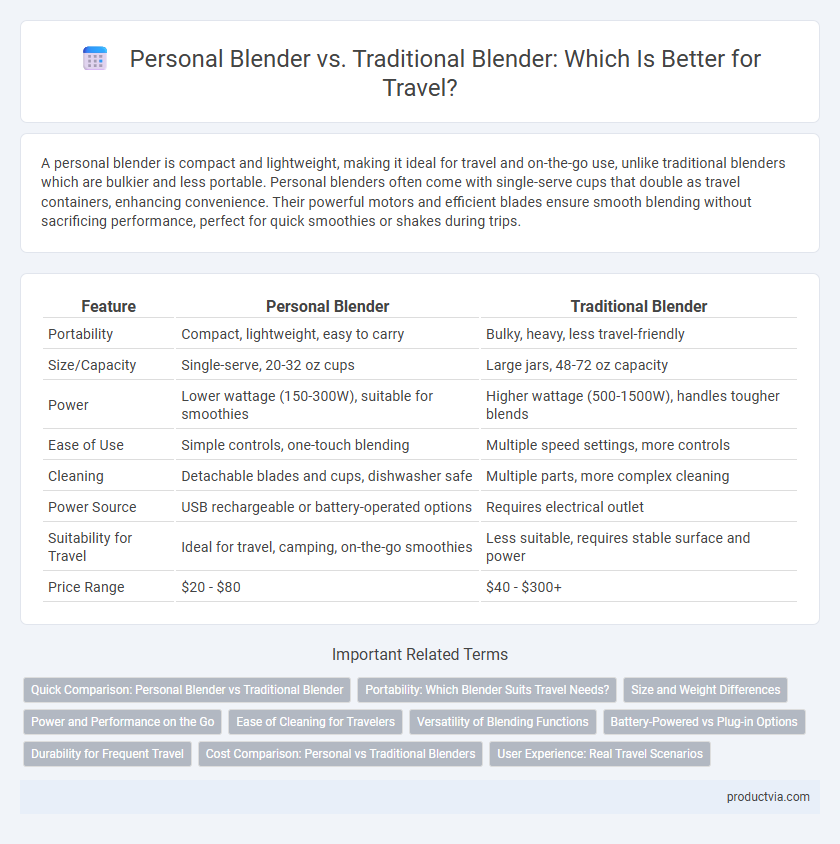A personal blender is compact and lightweight, making it ideal for travel and on-the-go use, unlike traditional blenders which are bulkier and less portable. Personal blenders often come with single-serve cups that double as travel containers, enhancing convenience. Their powerful motors and efficient blades ensure smooth blending without sacrificing performance, perfect for quick smoothies or shakes during trips.
Table of Comparison
| Feature | Personal Blender | Traditional Blender |
|---|---|---|
| Portability | Compact, lightweight, easy to carry | Bulky, heavy, less travel-friendly |
| Size/Capacity | Single-serve, 20-32 oz cups | Large jars, 48-72 oz capacity |
| Power | Lower wattage (150-300W), suitable for smoothies | Higher wattage (500-1500W), handles tougher blends |
| Ease of Use | Simple controls, one-touch blending | Multiple speed settings, more controls |
| Cleaning | Detachable blades and cups, dishwasher safe | Multiple parts, more complex cleaning |
| Power Source | USB rechargeable or battery-operated options | Requires electrical outlet |
| Suitability for Travel | Ideal for travel, camping, on-the-go smoothies | Less suitable, requires stable surface and power |
| Price Range | $20 - $80 | $40 - $300+ |
Quick Comparison: Personal Blender vs Traditional Blender
Personal blenders offer compact size, USB charging, and single-serve convenience ideal for travel, while traditional blenders provide larger capacity and powerful motors suited for extensive food preparation. Personal blenders typically weigh less than 2 pounds and blend directly into travel bottles, enhancing portability and ease of cleaning. Traditional blenders, often exceeding 5 pounds with glass jars and higher wattage motors above 500 watts, compromise travel convenience but deliver superior blending performance.
Portability: Which Blender Suits Travel Needs?
Personal blenders offer superior portability for travel due to their compact size and lightweight design, making them easy to pack and carry in bags. Traditional blenders are bulkier and heavier, often requiring more space and stable power sources, which limits their convenience on the go. For frequent travelers or those with limited luggage space, personal blenders provide a practical solution without sacrificing blending power.
Size and Weight Differences
Personal blenders are significantly smaller and lighter than traditional blenders, making them ideal for travel and on-the-go use. Their compact size typically ranges from 6 to 10 inches in height and weighs less than 3 pounds, compared to traditional blenders that can exceed 14 inches and 8 pounds. This size and weight difference enhance portability, allowing personal blenders to easily fit into backpacks, suitcases, or car compartments.
Power and Performance on the Go
Personal blenders typically feature compact, high-speed motors designed for efficient blending of smoothies and shakes, making them ideal for travel where space and portability matter. Traditional blenders offer more powerful motors and larger capacity but tend to be bulkier and less convenient for on-the-go use. For travel, personal blenders provide a balance of sufficient power and performance, enabling quick, smooth blending without the need for extensive setup or storage space.
Ease of Cleaning for Travelers
Personal blenders offer superior ease of cleaning for travelers due to their compact design and detachable components that are dishwasher safe or easily rinsed on the go. Traditional blenders typically have multiple parts and larger bases that are cumbersome to clean and dry during travel. Opting for a personal blender ensures quick cleanup with minimal effort, making it ideal for maintaining hygiene while on the move.
Versatility of Blending Functions
Personal blenders offer enhanced versatility for travel with multiple blending functions tailored for smoothies, sauces, and crushed ice, unlike traditional blenders that primarily handle basic blending tasks. Compact personal blenders often include pulse and variable speed settings, optimizing texture control in various recipes during transit. Their multi-functionality supports not only blending but also mixing and grinding, making them ideal for diverse culinary needs on the go.
Battery-Powered vs Plug-in Options
Personal blenders often feature battery-powered options, making them highly convenient for travel without relying on a power outlet. Traditional blenders typically require plug-in power, limiting their use to locations with accessible electricity. Choosing between battery-powered personal blenders and plug-in traditional blenders depends on portability needs and access to reliable power sources during travel.
Durability for Frequent Travel
Personal blenders often feature compact, lightweight designs with robust plastic or stainless steel components, making them more durable for frequent travel compared to traditional blenders. Their sealed, portable containers minimize breakage risks during transit, while traditional blenders usually consist of heavier, bulkier glass jars and less travel-friendly assemblies prone to damage. Investing in a personal blender with shatterproof materials and secure locking lids enhances durability and reliability for on-the-go blending needs.
Cost Comparison: Personal vs Traditional Blenders
Personal blenders typically range from $20 to $70, offering affordable options ideal for travel due to their compact size and portability, while traditional blenders often cost between $50 and $200 or more, reflecting their larger capacity and more powerful motors. The lower price point of personal blenders makes them a cost-effective choice for individuals who prioritize convenience and minimalist design on the go. In contrast, traditional blenders' higher initial investment provides multifunctionality suitable for home use but may not justify the extra cost for travel purposes.
User Experience: Real Travel Scenarios
Personal blenders offer a compact and lightweight design ideal for travel, allowing users to blend smoothies directly in portable cups that fit in car holders or backpacks. Traditional blenders, while powerful, tend to be bulky and require access to a stable power source, limiting convenience during trips. Real travel scenarios highlight the ease of cleaning and quick blending cycles in personal blenders, enhancing user experience on the go.
Personal blender vs traditional blender for travel Infographic

 productvia.com
productvia.com